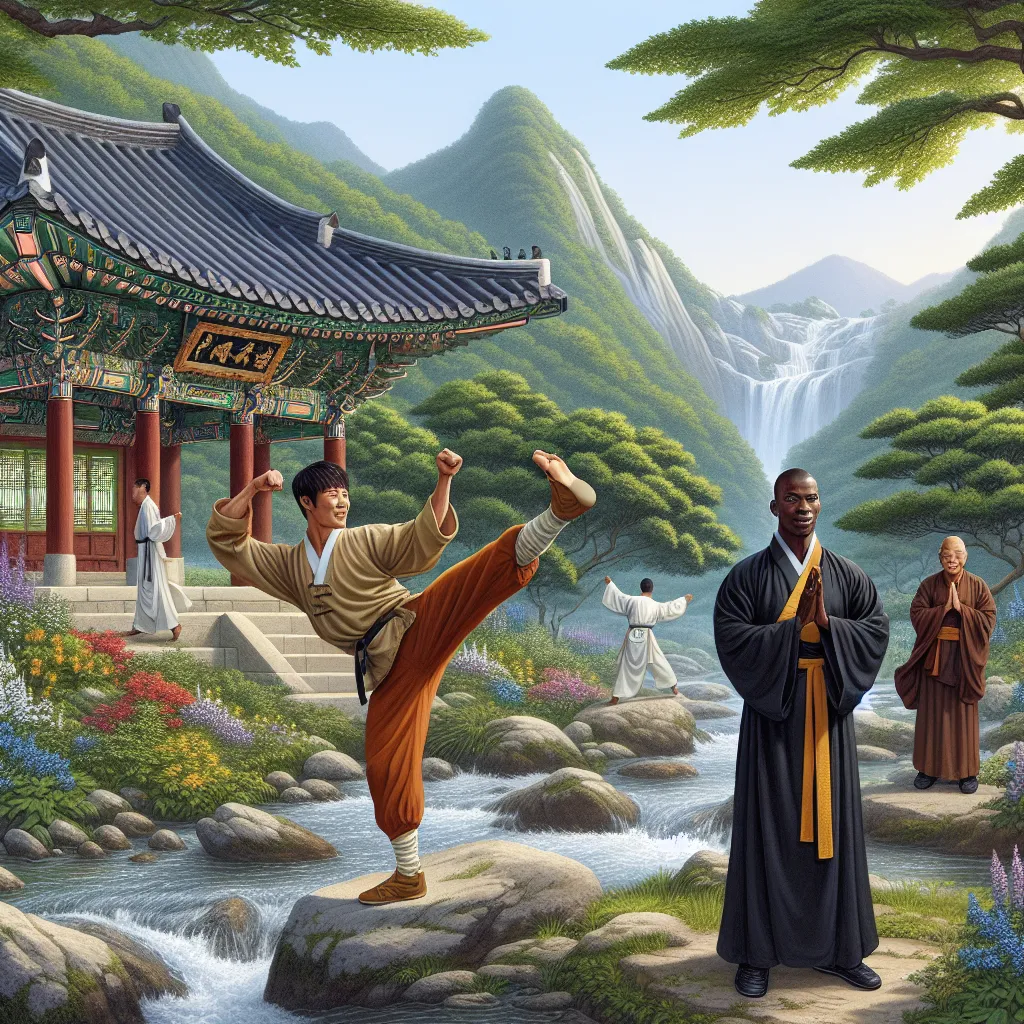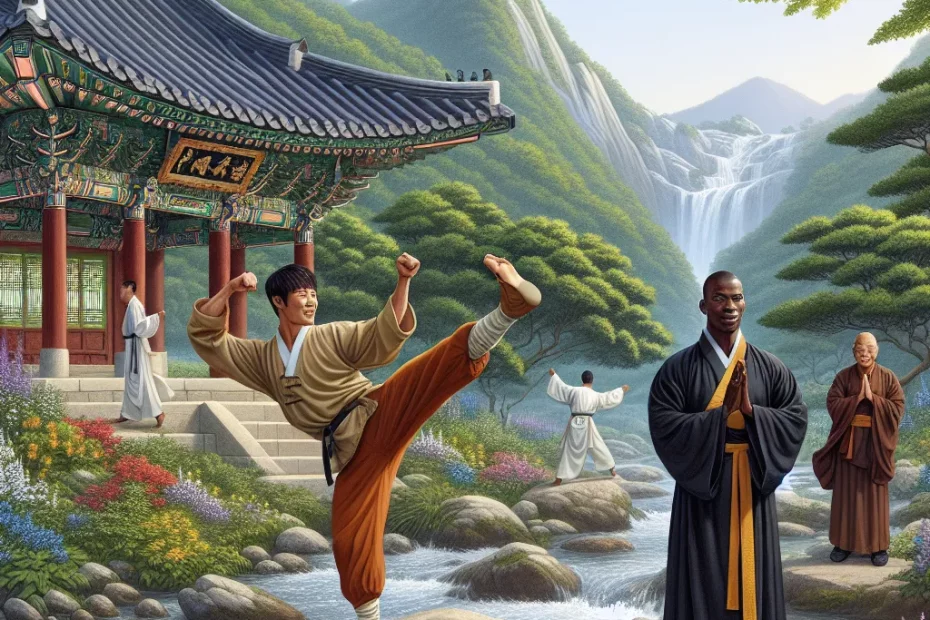Taoism, an ancient Chinese philosophy and religion, has had a profound influence on Korean culture throughout history. From art and architecture to literature, music, and daily rituals, the principles of Taoism have left a lasting imprint on various aspects of Korean society. Exploring Korea’s spiritual traditions allows us to delve into a rich tapestry of beliefs and practices that have shaped the country’s identity. By examining the manifestations of Taoist philosophy in Korean culture, we gain a deeper understanding of the spiritual underpinnings that continue to resonate in the modern era. Let’s embark on a journey to uncover the intricate connections between Taoism and Korean traditions, illuminating the spiritual heritage that endures to this day.

Taoist Principles in Korean Art and Architecture
In exploring the rich tapestry of Korean culture, one cannot overlook the profound influence of Taoism on the country’s art and architecture. The intertwining of Taoist principles with traditional Korean aesthetics has resulted in a unique and spiritually significant artistic tradition that continues to captivate audiences worldwide. 🎨🏯
The Influence of Taoism on Korean Art
Taoism, with its emphasis on harmony, balance, and nature, has deeply permeated Korean artistic expressions. From the intricate patterns adorning ancient palaces to the serene landscapes depicted in traditional paintings, the influence of Taoist philosophy is unmistakable. Korean artists and architects have long drawn inspiration from the natural world, seeking to capture the essence of the Tao in their creations. 🌿🎑
Yin and Yang in Korean Design
One of the key principles of Taoism reflected in Korean art and architecture is the concept of yin and yang. This duality of forces, representing complementary aspects of existence, is often symbolized in the contrasting elements found in Korean design. The harmony between light and shadow, movement and stillness, is carefully orchestrated to evoke a sense of balance and unity. 🌗⚖️
Embracing Imperfection: Wabi-Sabi Aesthetics
Another fundamental aspect of Taoist philosophy evident in Korean art is the idea of wabi-sabi, embracing imperfection and transience. This aesthetic values simplicity, humility, and the beauty of natural aging, mirroring the Taoist belief in the cyclical nature of existence. Korean pottery, with its deliberate cracks and irregularities, embodies the wabi-sabi ethos, inviting contemplation on the impermanence of life. 🏺🍃
Taoist Influence in Korean Architecture
In Korean architecture, the influence of Taoism can be seen in the design of traditional hanok houses. These wooden structures, characterized by their curved lines and natural materials, are built to harmonize with the surrounding landscape. The open floor plans and emphasis on natural light create a sense of interconnectedness with nature, reflecting the Taoist reverence for the environment. 🏡🌳
Overall, the integration of Taoist principles into Korean art and architecture has not only produced visually stunning masterpieces but also imbued them with a deeper spiritual meaning. The timeless wisdom of Taoism continues to inspire artists and architects in Korea, ensuring that this rich cultural heritage remains vibrant and relevant in the modern world. 🎨🏯
As we delve deeper into the intricate tapestry of Korean culture, the influence of Taoism emerges as a guiding force, shaping the artistic expressions and architectural marvels that define this captivating nation. 🇰🇷🌌
Influence of Taoism on Korean Festivals and Celebrations
Exploring the rich tapestry of Korean culture unveils a deep-rooted influence of Taoism on the country’s vibrant festivals and joyous celebrations. Taoism, with its emphasis on harmony with nature and spiritual balance, has seamlessly woven its way into the fabric of Korean traditions, shaping the way Koreans commemorate important events and honor their heritage. 🎉
The Celebration of Dano
One of the most prominent examples of Taoism‘s influence on Korean festivals is the celebration of Dano, a traditional holiday held on the fifth day of the fifth lunar month. This festival, originating from ancient shamanistic practices, embodies Taoist principles of balance and unity. During Dano, Koreans partake in various rituals and performances to ward off evil spirits and bring good fortune, reflecting Taoist beliefs in maintaining harmony and warding off negative energies. 🌿
Chuseok – Korean Thanksgiving
Another significant festival influenced by Taoism is Chuseok, also known as Korean Thanksgiving. This harvest festival, held on the 15th day of the eighth lunar month, is a time for families to come together, express gratitude, and pay respects to their ancestors. The rituals and ceremonies performed during Chuseok, such as offering food and performing ancestral rites, are deeply rooted in Taoist beliefs of honoring the past and maintaining spiritual connections with one’s lineage. 🌾
Lotus Lantern Festival
Furthermore, the Lotus Lantern Festival, celebrated annually to commemorate the birth of Buddha, showcases the fusion of Taoist and Buddhist influences in Korean culture. The festival, filled with colorful lanterns and vibrant parades, symbolizes enlightenment and spiritual awakening, echoing Taoist ideals of inner peace and enlightenment. The intricate lantern displays and joyful processions during this festival reflect the harmonious blend of Taoist and Buddhist traditions in Korean society. 🏮
In addition to these major festivals, Taoism‘s influence can be seen in various other celebrations throughout the Korean calendar. From the exuberant dances performed during Seollal (Lunar New Year) to the solemn rituals of Jeseok (Ancestor Memorial Rite), Taoist principles of balance, harmony, and spiritual connection permeate every aspect of Korean cultural festivities. 🎊
In conclusion, the influence of Taoism on Korean festivals and celebrations is a testament to the enduring impact of spiritual traditions on cultural practices. Through rituals, ceremonies, and symbolic gestures, Koreans continue to honor their heritage and connect with the divine, embodying the timeless wisdom of Taoist philosophy in their festive traditions. 🌟
Taoist Philosophy in Korean Literature and Music
In exploring the rich cultural tapestry of Korea, one cannot overlook the profound influence of Taoist philosophy on Korean literature and music. Dating back centuries, Taoism has woven its way into the spiritual fabric of Korean society, shaping artistic expressions and cultural practices. Let’s delve into how Taoist principles have manifested in Korean creative works, captivating audiences with their depth and wisdom! 📚🎶
Korean Literature: Harmony with Nature
Korean literature, known for its lyrical beauty and introspective themes, often reflects the core tenets of Taoism. The concept of harmony with nature, a central pillar of Taoist thought, resonates strongly in Korean poetry and prose. Writers draw inspiration from the natural world, using vivid imagery to convey a sense of interconnectedness with the universe. Through their words, they invite readers to contemplate the cyclical rhythms of existence and the transient nature of life. 🌿📖
Korean Literature: Balance of Opposites
Moreover, the Taoist belief in the balance of opposites finds expression in Korean literary works, where themes of yin and yang, light and darkness, find symbolic representation. This duality infuses narratives with complexity and depth, inviting readers to ponder the interplay of conflicting forces within the human experience. Korean authors skillfully weave these contrasting elements into their storytelling, creating nuanced characters and thought-provoking plotlines that resonate with audiences on a profound level. ☯️📚
Korean Music: Meditative Quality
Turning to the realm of music, traditional Korean melodies often echo the meditative quality of Taoist teachings. The gentle strains of traditional instruments, such as the gayageum and the daegeum, evoke a sense of tranquility and contemplation, mirroring the Taoist emphasis on inner harmony and spiritual enlightenment. Musicians draw from the natural world, incorporating sounds of flowing water, rustling leaves, and chirping birds to create immersive sonic landscapes that transport listeners to a state of peaceful introspection. 🎶🌊
Korean Music: Improvisational Spirit
Furthermore, the improvisational nature of traditional Korean music reflects the spontaneity and fluidity prized in Taoist philosophy. Musicians embrace the concept of wu wei, or effortless action, allowing the music to flow organically and intuitively. This improvisational spirit infuses performances with a sense of vitality and authenticity, captivating audiences with its raw emotional power and evocative storytelling. Through their music, Korean artists invite listeners to experience the beauty of the present moment and connect with the timeless rhythms of the universe. 🎵🌌
In conclusion, the influence of Taoist philosophy on Korean literature and music is a testament to the enduring power of ancient wisdom in shaping cultural expressions. From the lyrical verses of poets to the soul-stirring melodies of musicians, Taoism continues to inspire and enrich Korean artistic traditions, offering a glimpse into the profound mysteries of existence. As we immerse ourselves in the beauty of Korean creativity, let us embrace the timeless teachings of Taoism and discover the profound truths that resonate across time and space. 🌟📚🎶
Taoist Practices and Rituals in Korean Daily Life
In Korean culture, the influence of Taoism can be seen in various aspects of daily life, shaping spiritual traditions and practices that have been passed down for generations. Taoist principles emphasize harmony with nature, balance, and spiritual cultivation, all of which have deeply influenced Korean beliefs and customs. Let’s explore how Taoist practices and rituals are integrated into the daily lives of Koreans, enriching their spiritual journey.
Taoist Beliefs in Korean Culture
Taoism, with its roots in ancient China, found its way to Korea centuries ago and has since become intertwined with Korean shamanism and Buddhism. The concept of “Tao,” or the way, is central to Taoist beliefs, emphasizing living in accordance with the natural order of the universe. This philosophy resonates with Koreans, who value harmony and balance in all aspects of life.
Daily Rituals for Spiritual Connection
Koreans incorporate Taoist rituals into their daily routines to cultivate spiritual connection and inner peace. Practices such as meditation, qigong exercises, and tea ceremonies are common ways to align with the Tao and center the mind and body. These rituals serve as a reminder to stay present and mindful in a fast-paced world.
Honoring Ancestors and Nature
Ancestor veneration is a significant part of Korean culture, influenced by Taoist principles of respect for the past and gratitude for the present. Koreans pay homage to their ancestors through rituals and ceremonies, seeking their guidance and blessings. Additionally, connecting with nature through practices like forest bathing and mountain pilgrimages is another way Koreans honor the Tao and find spiritual solace.
Festivals and Celebrations
Korean festivals and celebrations often have Taoist origins, celebrating the changing seasons, agricultural traditions, and spiritual connections. Events like the Dano Festival and Chuseok (Korean Thanksgiving) incorporate Taoist rituals such as offerings to ancestors, traditional dances, and ceremonies to bring prosperity and good fortune to the community.
Divination and Folk Beliefs
Taoist practices of divination and fortune-telling have also seeped into Korean culture, with methods like saju (Four Pillars of Destiny) and physiognomy being used to gain insights into one’s destiny. Folk beliefs in spirits, talismans, and charms are prevalent in Korean society, reflecting a blend of Taoist, shamanistic, and Confucian influences.
Through Taoist practices and rituals, Koreans find a sense of connection to the divine, nature, and their ancestors, enriching their daily lives with spiritual depth and meaning. The fusion of Taoism with Korean culture continues to shape traditions and beliefs, highlighting the enduring influence of ancient wisdom in modern society.
The influence of Taoism on Korean culture is profound and far-reaching, shaping various aspects of Korean society from art and architecture to literature and daily life. Through Taoist principles, Koreans have developed a unique artistic and architectural style that reflects harmony with nature and the pursuit of balance. Taoism has also left its mark on Korean festivals and celebrations, infusing them with spiritual meaning and traditional rituals. In Korean literature and music, Taoist philosophy can be seen in themes of balance, harmony, and the interconnectedness of all things. Additionally, Taoist practices and rituals are integrated into Korean daily life, providing guidance on living in accordance with the natural order. Overall, the impact of Taoism on Korean culture is a testament to the enduring influence of spiritual traditions on society.
